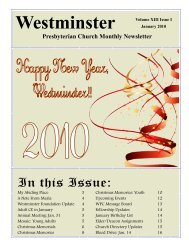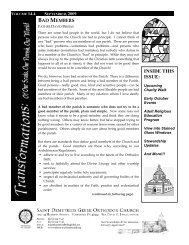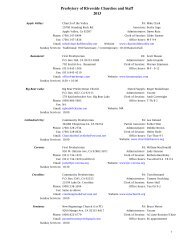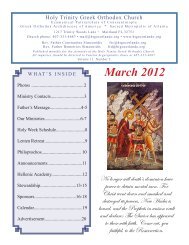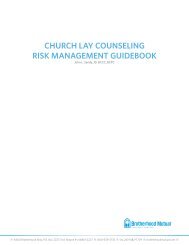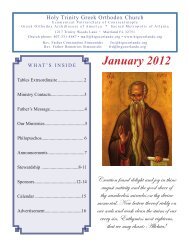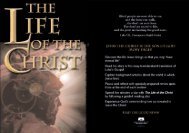OSIS? 2.0.1 User's Manual - Web services are running on AMBIB
OSIS? 2.0.1 User's Manual - Web services are running on AMBIB
OSIS? 2.0.1 User's Manual - Web services are running on AMBIB
You also want an ePaper? Increase the reach of your titles
YUMPU automatically turns print PDFs into web optimized ePapers that Google loves.
for weekly dates, and for named times of day (such as used in many prayer books). There<br />
<str<strong>on</strong>g>are</str<strong>on</strong>g> 3 standard date formats; the prefixes that identify them <str<strong>on</strong>g>are</str<strong>on</strong>g> reserved, and may not be<br />
redefined via the refSysId attribute of any work element:<br />
• yearly:yyyy-mm-ddThh.mm.ss<br />
Any number of fields may be left off from the right end; for example, if the<br />
sec<strong>on</strong>ds <str<strong>on</strong>g>are</str<strong>on</strong>g> dropped (al<strong>on</strong>g with the preceding col<strong>on</strong>), the time refers to the entire<br />
minute specified; if the entire time secti<strong>on</strong> is left off (al<strong>on</strong>g with the preceding<br />
"T"), the string refers to the entire day.<br />
The year must always have 4 digits. However, the year may be entirely omitted to<br />
indicate dates that apply to any year, such as in a book of 365 daily readings.<br />
To indicates years before the comm<strong>on</strong> era, add an underscore ("_") before the first<br />
digit of the year (immediately following the col<strong>on</strong>). A hyphen would be<br />
preferable, but it is already in use to indicate ranges in osisRefs.<br />
The entire date/time string (possibly including a leading underscore) may be<br />
preceded by "~", indicating that the time is approximate. No means is provided to<br />
express just how approximate a time may be.<br />
• weekly:n<br />
When readings or other materials <str<strong>on</strong>g>are</str<strong>on</strong>g> specified as being for particular days of the<br />
week, this form must be used. The 'n' value may range from 1 to 7; 1 indicates<br />
M<strong>on</strong>day, in accordance with ISO 8601:2000.<br />
As an alternative to quantitative times, a small set of named times is provided, which can<br />
be specified in place of the entire (post-"T") time secti<strong>on</strong> (the "T" itself remains). For<br />
example:<br />
yearly:06-04T~(Vespers)<br />
would be the identifier for a prayer, reading, or other work to be used at Vespers <strong>on</strong> June<br />
4 of any year. The named times (which <str<strong>on</strong>g>are</str<strong>on</strong>g> case-sensitive) include: Vigils, Matins, Lauds,<br />
Terce, Sext, N<strong>on</strong>e, Vespers, Compline; Sunrise, Sunset; Morning, Afterno<strong>on</strong>, Evening,<br />
Night; AM, PM; Fajr, Zuhr, _Asr, Maghhrib, _Isha, Lail, Dzuha, _Id.<br />
Some works will be primarily organized by dates and times: for example, lecti<strong>on</strong>aries,<br />
daily devoti<strong>on</strong>als, prayer books, historical time lines, etc. In such works, use the osisID<br />
attribute to identify the retrievable porti<strong>on</strong>s; the value should the the applicable time in<br />
<strong>on</strong>e of the formats just shown.<br />
Typically, such works <str<strong>on</strong>g>are</str<strong>on</strong>g> organized in chgr<strong>on</strong>ological order of the times specified;<br />
however, <str<strong>on</strong>g>OSIS</str<strong>on</strong>g> does not impose that requirement.



